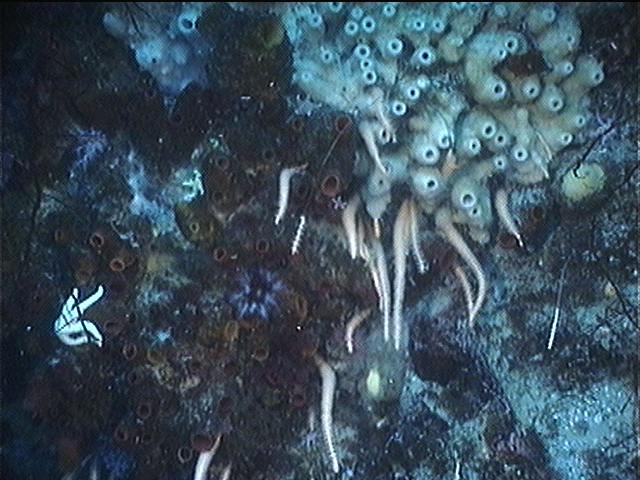Imagine yourself pulling on a cumbersome rubber suit over bulky underwear. You're zippered closed. And the sweat begins to flow. Heavy gloves, giving about as much dexterity as boxing gloves, are pulled over your hands and duct taped (what would we do without duct tape here?). Some 35 pounds of lead are wrapped around your waist and a heavy set of double steel tanks is mounted on your back. Flippers on your feet and a face mask over your head, with your hair being up-rooted by the moving straps and probing fingers that effect a good seal (image1
 ).
You feel like you're in a sauna. But not for long.
).
You feel like you're in a sauna. But not for long.
As you slip into the hole in the sea ice and are surrounded by a swirl of ice platelets, everything changes (image 2
 ).
Your lips and face sting with cold, but quickly go numb. The hole
is barely wide enough to slide through, and 6 to 7 feet of ice make the
tunnel seem endless. Claustrophobia flirts with your inner fears.
).
Your lips and face sting with cold, but quickly go numb. The hole
is barely wide enough to slide through, and 6 to 7 feet of ice make the
tunnel seem endless. Claustrophobia flirts with your inner fears.
And then you're through. Some 75 feet about the bottom, hanging in crystal clear but dimly-lit water. It's like dropping through the dome of an immense cathedral. Areas on the sea ice near the hole that were cleared of snow earlier by a tractor let shafts of light stream down giving the impression of light penetrating unwashed glass windows. Far below, indistinct shapes and colors show a pattern of whitish or yellowish mounds and domes against a darker background. In one direction the view seems endless as the light fades out into a blue-gray hue. In the other, the slope of the sea floor rises up in cliffs and ridges to touch the bottom of the sea ice, or to translucent ice walls and caverns that line the shore. From below, the sea ice looks like the bottom of a heavy cloud bank (image 3), with dark patches (diatoms) and light streaks (following the courses of cracks in the ice). Ice tubes, formed when water freezes around dense streams of brine dropping out of overlying sea ice, look like stalactites, or ornate medieval decorations (image 4)
 .
.
As you drift downward, and the hole diminished to a small spot in the ceiling above, the enormity of the place begins to sink into your being. It's like space walking. Claustrophobia turns to acrophobia. Just you and your partner, connected to each other and the surface by a strand of nylon line (image 5). Medusas and comb jellies drift by in gentle currents.
The forms on the bottom begin to reveal themselves as a jumble of sponges, anemones, soft corals, and other forms of sessile life (image 6
 ).
A variety of sea stars are scattered about with the velvety little red
one being particularly abundant everywhere. The diversity of life
becomes a thing in itself as you slowly swim along the sea floor.
Sea urchins, sea spiders, feather stars, sea squirts, clams, snails, fishes,
shrimps, bristle worms, scuds, sea slugs, slaters, scallops, octopuses,
brittle stars, ribbon worms (including rather grotesque, large slimy ones
that tend to intertwine together in massive congregations-- what are they
doing?). A seal glides by effortlessly, giving you a wary eye.
Hey, is this the lifeless Antarctic or what?
).
A variety of sea stars are scattered about with the velvety little red
one being particularly abundant everywhere. The diversity of life
becomes a thing in itself as you slowly swim along the sea floor.
Sea urchins, sea spiders, feather stars, sea squirts, clams, snails, fishes,
shrimps, bristle worms, scuds, sea slugs, slaters, scallops, octopuses,
brittle stars, ribbon worms (including rather grotesque, large slimy ones
that tend to intertwine together in massive congregations-- what are they
doing?). A seal glides by effortlessly, giving you a wary eye.
Hey, is this the lifeless Antarctic or what?
A tug on the tether line and you realize that already over a half hour has passed in this timeless, near boundless setting. You anxiously look for your partner and for the line leading upward to the escape route above. A slow ascent and an ungainly exit, and you're out again in "your" world of air, and the near lifeless Antarctic ice and snow.